The heavy defeat of Napoleon's army near Krasnoe
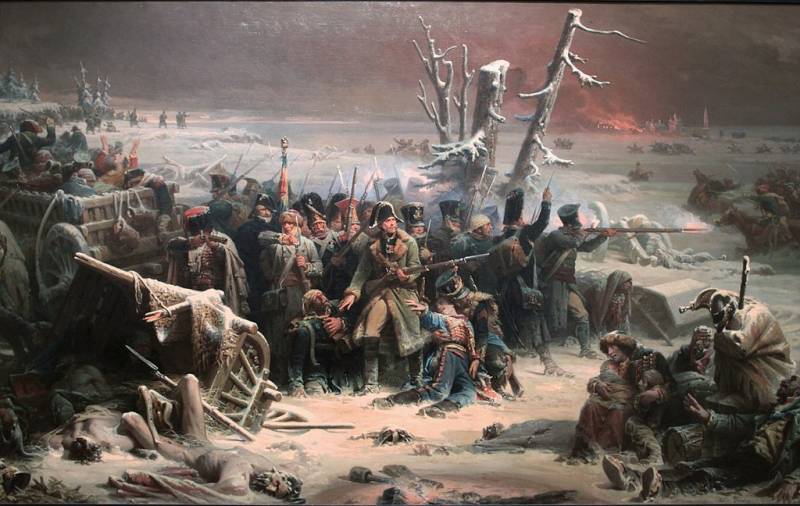
Soldiers of Marshal Ney, driven into the forest. Hood. Adolphe Yvon
General situation
The French, having arrived in Smolensk, considered themselves safe. Napoleon even planned to stay here. Smolensk was to become the advanced fortress of the Great Army, which was to be placed in winter quarters between Mogilev, Orsha and Vitebsk. Bonaparte ordered the corps of Oudinot and Victor to push the enemy back beyond the Western Dvina in order to restore the situation in the northern direction (Fierce oncoming battle near Smolyan).
They tried to put the frustrated army in order and strengthen it. The infantry received the missing weapons from the arsenals (many, during the retreat, threw weapon, to make it easier to leave) and a full load of ammunition (50 rounds per soldier). The rest of the artillery also tried to put in order. The emperor gave the order to urgently hand over the horses from the troops of the second line. An order was sent to Orsha to increase stocks. The number of Napoleon's army was about 70-80 thousand people, of which about 45-50 thousand were relatively combat-ready.
However, after a few days it became clear that the situation was much worse than it seemed at first. News came about the defeat of the Beauharnais corps on the Vop River, the Italian troops suffered heavy losses, lost most of their artillery and supplies, fled to Smolensk (How the Dons defeated the Beauharnais Corps). At the same time, Augereau's brigade was defeated and capitulated near the village of Lyakhovo, de Illier's division rolled back to Smolensk.
This allowed the Russian army to reach Krasnoye before the French, repeating the situation at Vyazma. It also became known about the loss of Vitebsk with its warehouses and the failure of Marshal Victor in the fight against Wittgenstein. Wittgenstein's northern Russian army was within a four-day throw from Borisov.
Thus, there was a threat that the Russians would come out on the flanks of the main French forces and intercept the main road. Very angry Napoleon ordered to retreat further. On November 2 (14), 1812, the French army moved west. The troops again moved in one column and were greatly stretched out. In the forefront was the 5th corps of Joseph Zayonchek (the general replaced the ill Poniatowski), followed by Junot's 8th corps, the imperial guard and the rest of the troops. Ney's 3rd Corps was still in the rearguard, which entered the devastated Smolensk after the departure of other formations. Contrary to the order of the emperor, the marshal was forced to stay in the city in order to restore at least some order in the corps, give people a rest, replenish supplies of provisions and ammunition.
By the evening of November 3 (15), the guards, Junot's corps and Murat's cavalry reached Krasnoy. But here it turned out that the city had already been captured by the Russians. Ozharovsky's detachment captured the French garrison stationed in Krasnoe. Cossacks also appeared, who disturbed the French troops with their raids.
Caulaincourt wrote:
Bonaparte ordered the enemy to be driven out of the city and stopped, waiting for the approach of other troops.
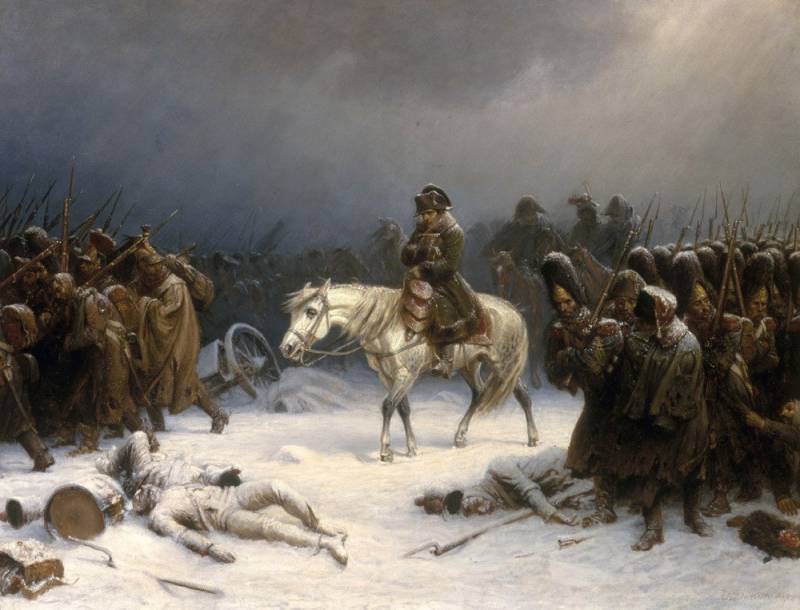
"Napoleon's Retreat from Russia". A. Norten
The Russian Army
The Russian army moved parallel to the enemy along the southern road, making the so-called flank march. Kutuzov's headquarters believed that the French could split up and withdraw from Smolensk in several directions. In the north, connect with the grouping of Oudinot and Victor, or go south of Smolensk, creating an operational line to Roslavl, Rogachev and further through Slutsk to Nesvizh in order to connect with the troops of Rainier and Schwarzenberg.
To monitor the actions of the enemy, the Russian commander-in-chief sent the 4th Infantry and 4th Cavalry Corps forward, south of Smolensk. The main forces of the army moved from the Roslavl to the Mstislav road. Having received a message from the vanguard of Miloradovich that the enemy was moving along the road to Orsha, Kutuzov considered that part of the French troops had passed Red. This posed a threat to Wittgenstein's army. Also, news came from Chichagov that his troops had reached Minsk. That is, Napoleon could no longer retreat in a southerly direction.
Kutuzov instructed Miloradovich to increase pressure on the enemy, to cut off and defeat part of the French army at Krasnoe. Two cuirassier divisions under the command of Golitsyn were sent to reinforce the vanguard. Miloradovich and Golitsyn were to establish contact and act jointly with the partisans and Ozharovsky's detachment.
At the same time, Kutuzov ordered the detachments of Ozharovsky and Davydov to conduct reconnaissance in force. Ozharovsky's detachment was reinforced by cavalry, it included two Poltava Cossack regiments, two Don Cossack regiments, a Mariupol hussar regiment, the 19th Chasseur regiment and 6 horse artillery guns.
On October 28 (November 9), Ozharovsky's detachment attacked and defeated the French in the village of Khmara. On November 2 (14), Ozharovsky occupied Krasny with a fight and captured the enemy garrison.
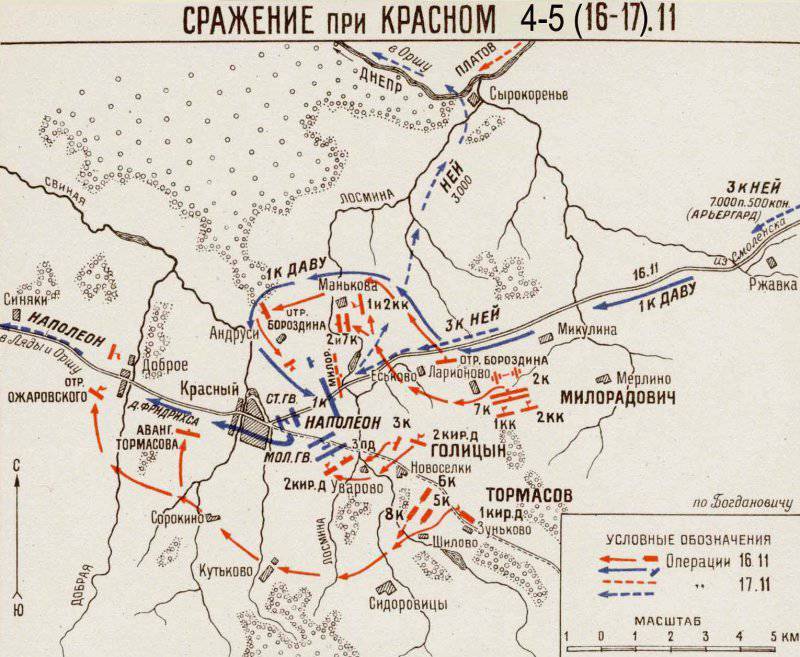
The breakthrough of the guard and the defeat of the Ozharovsky detachment
On November 3 (15), 1812, the division of General Claparede from the Young Guard drove out Ozharovsky's "flying" detachment from Krasnoye. The Russian detachment retreated to Kutkovo. At 4 p.m. Miloradovich's vanguard (2nd, 7th infantry, 1st cavalry corps, about 18 thousand people with 100 guns) went to the Smolensk road in the Rzhavka region and deployed his troops along the road.
At this time, the French guards, led by Napoleon himself, were moving along the road. Miloradovich did not dare to attack the enemy, most of the imperial guards passed by (12-13 thousand). Russian troops limited themselves to shelling the enemy.
The attacks of the partisans were easily repulsed by the guards. Denis Davydov in his Diary of Partisan Actions of 1812 wrote:
Miloradovich attacked the rear columns of the enemy and, after a stubborn battle, dispersed them. 2 thousand prisoners and 11 guns were captured. Then the imperial guard was attacked by the army partisan detachment of Orlov-Denisov, but without much loss for the French. Davydov recalled:
Napoleon's guards entered Krasny and waited for the rest of the formations.
Having received the news that a separate Russian detachment was located not far from Red, Bonaparte ordered the Young Guard to attack him. On the night of November 3-4, a division under the command of General Horn attacked Ozharovsky's detachment. The Russians were taken by surprise, as they rested nonchalantly without posting guards. The Russian detachment lost half of its people. The absence of cavalry did not allow Horn to develop success.
Defeat of Beauharnais
On November 4 (16), in the afternoon, the 4th Corps of Beauharnais came out to the position of Miloradovich, who moved to Merlino. The commander of the 4th Infantry Division, Eugene of Württemberg, advanced artillery onto the road and began shelling the enemy's advanced columns. He was reinforced by the regiments of the 12th and 26th divisions of the 7th corps. The lead column of the Italian viceroy's corps was dispersed.
Miloradovich made the mistake of weakening the main direction: he withdrew all three divisions from the highway and placed them parallel to the road, leaving only two infantry regiments to cover the artillery. Beauharnais was offered to capitulate. The Viceroy decided to break through. The remnants of Broussier's 14th Infantry Division were the first to break through. The attack was repelled by Russian artillery. Then Ornano's 13th division entered the battle, but it was surrounded by Russian cavalry and surrendered. Ornano himself was seriously wounded, he was considered dead and left, at night his adjutant carried the general to the location of his troops.
Then the 15th division and the remaining parts of the corps tried to break through. The French and Italians attacked in three columns. The left column was blocked and threw out a white flag, the middle one was scattered by artillery fire, only part of the right column was able to break into Krasny. As a result, the 4th Corps was completely defeated and lost its combat effectiveness. The troops of the viceroy lost 2 thousand people only as prisoners of the remaining 6 thousand, as well as the remaining guns and carts.
The news of the defeat of Beauharnais forced Napoleon to return the Guards Corps to Krasny. Only the troops of Junot and Poniatowski continued to move towards Orsha.
On the same day, Kutuzov's main forces reached Krasnoye and concentrated 5 km east of the city. The military council decided to attack. The troops advanced in two columns.
Tormasov's main column: 5th, 6th, 8th infantry corps, 1st cuirassier division, Rosen's vanguard and Ozharovsky's detachment (22-23 thousand bayonets and sabers with 120 guns), from the morning of November 5 (17) was supposed to bypass the city from the south and through Sidorovichi and Sorokino go to the village of Good and block the enemy's path to the west.
The auxiliary column of Golitsyn: the 3rd infantry corps, the 2nd cuirassier division and the Chernigov regiment (about 15 thousand people), was supposed to act a little later than the Tormasov column and go to the village of Uvarovo to hit the enemy from the southeast. Miloradovich's troops were to attack the French from the east.
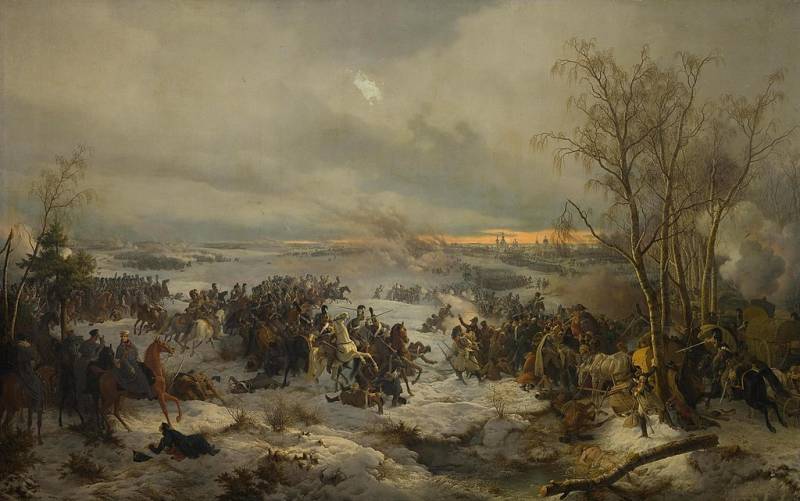
"Battle of the Red". Peter von Hess
The defeat of Davout and the counterattack of the French Guard
On November 5 (17), when the columns of Tormasov and Golitsyn were moving towards their designated points, the head column of Davout's 1st Corps (7,5 thousand people with 15 guns) appeared on the Smolensk road. The French marshal withdrew from the camp located near Rzhavka at about 3 o'clock in the morning when he received the news of the defeat of Beauharnais. Davout did not wait for Ney's corps and set out.
Our troops, who held the road at gunpoint, fired at the enemy columns. However, Miloradovich, having the order of the commander-in-chief to let the enemy through (they planned to block the French between the groups of Golitsyn and Miloradovich), did not attack Davout's corps. Therefore, the troops of the 1st corps went to the Red, although they suffered losses.
Napoleon, fearing that the 1st Corps would be cut off and defeated, decided to launch a counterattack. Early in the morning, the imperial guards began to move from Krasnoye to the south and southwest. The guards marched in two columns: 5 thousand marched along the road to Smolensk, the remaining 6 thousand of the Young Guard under the command of Horn moved to Uvarovo. Napoleon supported the troops with his personal presence.
This step of the enemy was unexpected for the Russian command. It was believed that the French guards, the corps of Poniatowski and Junot had already left Krasny. The French drove Golitsyn's forces out of Uvarovo (only two battalions were stationed there). Our troops opened fierce artillery fire on the village, which caused great damage to the Young Guard. Further French attacks were unsuccessful.
Bonaparte did not plan to wage a decisive battle near Krasny, therefore, as the units of the 1st Corps approached, they were heading along the road to Orsha. At about 11 o'clock in the afternoon, when most of Davout's corps was behind Red, the emperor received news that the enemy was coming to Dobrogo. At the same time, Golitsyn's troops became more active near Uvarovo. The young guard suffered serious losses (lost half of the composition).
Napoleon makes a difficult decision: to immediately withdraw the troops, saving them, but sacrificing Ney's corps. In the forefront were the Old Guard and the remnants of the Viceroy's corps. Davout was left to command the troops in Krasnoe. The young guards remained near Uvarov, but soon they began to retreat.
Tormasov did not have time to intercept the enemy, because when the enemy attacked Uvarovo, he received an order to reinforce Golitsyn. When it became clear that the French were retreating, Tormasov again received the order to go to Good, but it was already too late. However, the detachments of Rosen and Ozharovsky were able to deliver a strong blow to the rearguard of the Davout corps at Dobry, actually destroying it.
At night, the Russian army deployed in Krasnoye and its environs.
Defeat of Ney
Marshal Ney set out from Smolensk on November 5 (17). Leaving the city, the marshal, on the orders of Bonaparte, blew up the Royal Gate, 8 Godunov towers and almost all large buildings. The French abandoned 140 of their guns, 17 captured Russians and most of the convoy. 4 thousand wounded were left in hospitals. The French troops marched on Krasny, not knowing that the rest of the corps had gone further west, and the road was completely closed by the Russians. In the 3rd Corps, 8,5 thousand combat-ready soldiers remained with 12 guns, and another 7-8 thousand people followed in a crowd behind his column. Ney's corps could not break through the superior forces of the Russians.
On the evening of November 5, Ney went out to Korytna, heard the cannonade from Krasny, but considered that it was Victor's corps that was going to the army, and did not attach much importance to the shooting. At dawn on November 6, the 3rd Corps continued to move. The appearance of the Russians at the crossing over the Losmina River was unexpected for him. The 2nd and 7th Infantry Corps occupied the positions on the river, which advanced the artillery. On the left flank was a cuirassier division, on the right - the 2nd cavalry corps.
The marshal decided that there were people in Krasnoye, and he only needed to break through the Russian orders. Miloradovich invited Ney to capitulate. The bravest of the brave, as Napoleon called him, decided to make a breakthrough. The marshal ordered the 11th division to Raz to attack the Russian position in order to break into the city. Under the cover of fog and fire of 6 guns, the French went on the attack. However, Russian artillery quickly overwhelmed the weak French battery. Buckshot stopped the infantry. The troops of the Russian 12th and 26th infantry divisions, two regiments of the 1st grenadier division, supported by cavalry, launched a counterattack and overturned the French.
Ney threw Ledru's 10th division into the attack. At this time, the marshal pulled up the remaining units and carts, but the situation was already catastrophic. Ledru's division was routed and surrendered. The marshal abandoned crowds of incapacitated soldiers and with a 3-strong detachment went through forest paths to the Dnieper. 12 thousand people laid down their arms.
Ney with his detachment went north, crossed Losminka near the village of Syrokorene. Then he crossed the Dnieper on thin ice, losing many people who fell through the ice. On November 20, the brave marshal reached Orsha with 800-900 fighters. The 3rd Corps was no more.
In the four-day battle near Krasnoe, the French army suffered a heavy defeat. The French lost 10-13 thousand people killed and wounded, 20-26 thousand people captured, about 200 guns (Clausewitz reports 230 guns), almost all the carts. Napoleon's army was left without cavalry and artillery. The corps of Beauharnais and Ney were completely defeated, and Davout's corps suffered heavy losses. The army barely escaped complete annihilation and rushed to the Berezina. Plans to stay in winter quarters west of Smolensk collapsed.
The losses of the Russian army were insignificant - 2 thousand people. For the battle near Red Kutuzov received the title of Prince of Smolensk.
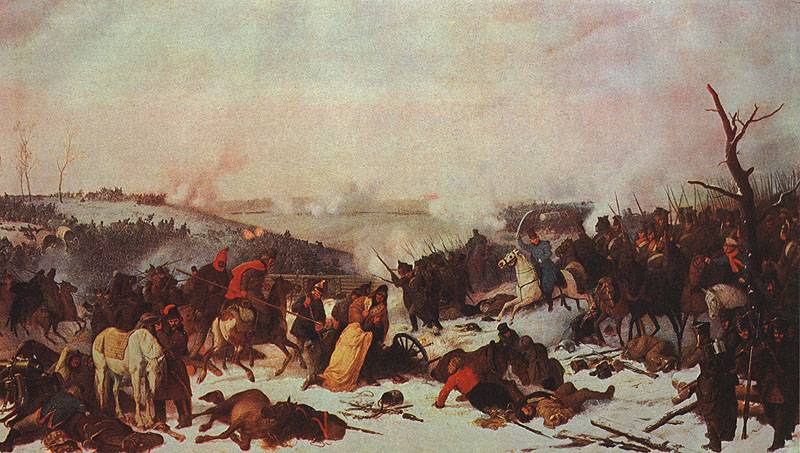
Battle of Losmin on November 6, 1812 (breakthrough of Ney). Hood. Peter von Hess
Information